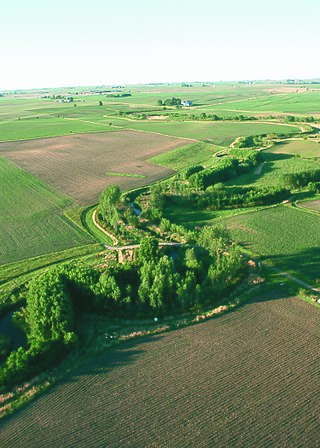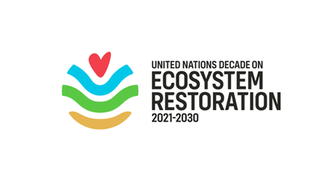
Natural capital is the world's stock of natural resources, which includes geology, soils, air, water and all living organisms. Some natural capital assets provide people with free goods and services, often called ecosystem services. All of these underpin our economy and society, and thus make human life possible.
Environmental economics is a sub-field of economics concerned with environmental issues. It has become a widely studied subject due to growing environmental concerns in the twenty-first century. Environmental economics "undertakes theoretical or empirical studies of the economic effects of national or local environmental policies around the world. ... Particular issues include the costs and benefits of alternative environmental policies to deal with air pollution, water quality, toxic substances, solid waste, and global warming."

Ecological economics, bioeconomics, ecolonomy, eco-economics, or ecol-econ is both a transdisciplinary and an interdisciplinary field of academic research addressing the interdependence and coevolution of human economies and natural ecosystems, both intertemporally and spatially. By treating the economy as a subsystem of Earth's larger ecosystem, and by emphasizing the preservation of natural capital, the field of ecological economics is differentiated from environmental economics, which is the mainstream economic analysis of the environment. One survey of German economists found that ecological and environmental economics are different schools of economic thought, with ecological economists emphasizing strong sustainability and rejecting the proposition that physical (human-made) capital can substitute for natural capital.
Overconsumption describes a situation where a consumer overuses their available goods and services to where they can't, or don't want to, replenish or reuse them. In microeconomics, this may be described as the point where the marginal cost of a consumer is greater than their marginal utility. The term overconsumption is quite controversial in use and does not necessarily have a single unifying definition. When used to refer to natural resources to the point where the environment is negatively affected, is it synonymous with the term overexploitation. However, when used in the broader economic sense, overconsumption can refer to all types of goods and services, including manmade ones, e.g. "the overconsumption of alcohol can lead to alcohol poisoning". Overconsumption is driven by several factors of the current global economy, including forces like consumerism, planned obsolescence, economic materialism, and other unsustainable business models and can be contrasted with sustainable consumption.

The Global Environment Facility (GEF) is a multilateral environmental fund that provides grants and blended finance for projects related to biodiversity, climate change, international waters, land degradation, persistent organic pollutants (POPs), mercury, sustainable forest management, food security, and sustainable cities in developing countries. It is the largest source of multilateral funding for biodiversity globally, and distributes more than $1 billion a year on average to address inter-related environmental challenges.
A green economy is an economy that aims at reducing environmental risks and ecological scarcities, and that aims for sustainable development without degrading the environment. It is closely related with ecological economics, but has a more politically applied focus. The 2011 UNEP Green Economy Report argues "that to be green, an economy must not only be efficient, but also fair. Fairness implies recognizing global and country level equity dimensions, particularly in assuring a Just Transition to an economy that is low-carbon, resource efficient, and socially inclusive."
Ecosystem valuation is an economic process which assigns a value to an ecosystem and/or its ecosystem services. By quantifying, for example, the human welfare benefits of a forest to reduce flooding and erosion while sequestering carbon, providing habitat for endangered species, and absorbing harmful chemicals, such monetization ideally provides a tool for policy-makers and conservationists to evaluate management impacts and compare a cost-benefit analysis of potential policies. However, such valuations are estimates, and involve the inherent quantitative uncertainty and philosophical debate of evaluating a range non-market costs and benefits.

Ecosystem services are the many and varied benefits to humans provided by the natural environment and healthy ecosystems. Such ecosystems include, for example, agroecosystems, forest ecosystem, grassland ecosystems, and aquatic ecosystems. These ecosystems, functioning in healthy relationships, offer such things as natural pollination of crops, clean air, extreme weather mitigation, and human mental and physical well-being. Collectively, these benefits are becoming known as ecosystem services, and are often integral to the provision of food, the provisioning of clean drinking water, the decomposition of wastes, and the resilience and productivity of food ecosystems.
The Stern Review on the Economics of Climate Change is a 700-page report released for the Government of the United Kingdom on 30 October 2006 by economist Nicholas Stern, chair of the Grantham Research Institute on Climate Change and the Environment at the London School of Economics (LSE) and also chair of the Centre for Climate Change Economics and Policy (CCCEP) at Leeds University and LSE. The report discusses the effect of global warming on the world economy. Although not the first economic report on climate change, it is significant as the largest and most widely known and discussed report of its kind.

Sustainability is a societal goal that relates to the ability of people to safely co-exist on Earth over a long time. Specific definitions of sustainability are difficult to agree on and have varied with literature, context, and time. Sustainability is commonly described as having three dimensions : environmental, economic, and social. Many publications state that the environmental dimension is the most important. For this reason, in everyday use, "sustainability" is often focused on countering major environmental problems, such as climate change, loss of biodiversity, loss of ecosystem services, land degradation, and air and water pollution. The concept of sustainability can be used to guide decisions at the global, national, and individual levels.

The natural environment, commonly referred to simply as the environment, includes all living and non-living things occurring naturally on Earth.
Earth Economics is a 501(c)(3) non-profit headquartered in Tacoma, Washington, United States. The organization uses natural capital valuation to help decision makers and local stakeholders understand the value of natural capital assets. By identifying, monetizing, and valuing natural capital and ecosystem services, Earth Economics goal is to help communities and organizations make investment and policy decisions. The organization has a small in-house staff of economists.
An environmental profit and loss account is a company's monetary valuation and analysis of its environmental impacts including its business operations and its supply chain from cradle-to-gate. An E P&L internalizes externalities and monetizes the cost of business to nature by accounting for the ecosystem services a business depends on to operate in addition to the cost of direct and indirect negative impacts on the environment. The primary purpose of an E P&L is to allow managers and stakeholders to see the magnitude of these impacts and where in the supply chain they occur.

Pavan Sukhdev is an Indian environmental economist whose field of studies include green economy and international finance. He was the Special Adviser and Head of UNEP's Green Economy Initiative, a major UN project suite to demonstrate that greening of economies is not a burden on growth but rather a new engine for growing wealth, increasing decent employment, and reducing persistent poverty. Pavan was also the Study Leader for the ground breaking TEEB study commissioned by G8+5 and hosted by UNEP. Under his leadership, TEEB sized the global problem of biodiversity loss and ecosystem degradation in economic and human welfare terms, and proposed solutions targeted at policy-makers, administrators, businesses and citizens. TEEB presented its widely acclaimed Final Report suite at the UN meeting by Convention on Biological Diversity (CBD) in Nagoya, Japan.
Natural capital accounting is the process of calculating the total stocks and flows of natural resources and services in a given ecosystem or region. Accounting for such goods may occur in physical or monetary terms. This process can subsequently inform government, corporate and consumer decision making as each relates to the use or consumption of natural resources and land, and sustainable behaviour.

Biodiversity offsetting is a system used predominantly by planning authorities and developers to fully compensate for biodiversity impacts associated with economic development, through the planning process. In some circumstances, biodiversity offsets are designed to result in an overall biodiversity gain. Offsetting is generally considered the final stage in a mitigation hierarchy, whereby predicted biodiversity impacts must first be avoided, minimised and reversed by developers, before any remaining impacts are offset. The mitigation hierarchy serves to meet the environmental policy principle of "No Net Loss" of biodiversity alongside development.

The term Nature-based solutions (NBS) refers to the sustainable management and use of natural features and processes to tackle socio-environmental challenges. These challenges include issues such as climate change, water security, water pollution, food security, human health, biodiversity loss, and disaster risk management. The European Commission's definition of NBS states that these solutions are "inspired and supported by nature, which are cost-effective, simultaneously provide environmental, social and economic benefits and help build resilience. Such solutions bring more, and more diverse, nature and natural features and processes into cities, landscapes, and seascapes, through locally adapted, resource-efficient and systemic interventions". In 2020, the EC definition was updated to further emphasise that “Nature-based solutions must benefit biodiversity and support the delivery of a range of ecosystem services.” Through the use of NBS healthy, resilient, and diverse ecosystems can provide solutions for the benefit of both societies and overall biodiversity.

Karachepone N. Ninan is an ecological economist. Dr. Ninan was born in Nairobi, Kenya where he had his early school education. Thereafter he relocated to India where he continued his high school and college education.

Clive L. Spash is an ecological economist. He currently holds the Chair of Public Policy and Governance at Vienna University of Economics and Business, appointed in 2010. He is also Editor-in-Chief of the academic journal Environmental Values.

The United Nations Decade on Ecosystem Restoration runs from 2021 to 2030. Similar to other nature related international decades, its purpose is to promote the United Nation's environmental goals. Specifically, to facilitate global cooperation for the restoration of degraded and destroyed ecosystems. Along with fostering efforts to combat climate change, safeguard biodiversity, food security, and water supply. While much focus is on promoting restoration activity by national governments, the UN also wishes to promote such efforts from other actors, ranging from the private sector and NGOs to regular individuals.












